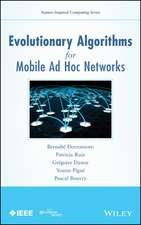Optimizing Wireless Communication Systems
Editat de Francisco Rodrigo Porto Cavalcanti, Sören Anderssonen Limba Engleză Hardback – 5 aug 2009
| Toate formatele și edițiile | Preț | Express |
|---|---|---|
| Paperback (1) | 1229.10 lei 6-8 săpt. | |
| Springer Us – 26 noi 2014 | 1229.10 lei 6-8 săpt. | |
| Hardback (1) | 1235.43 lei 6-8 săpt. | |
| Springer Us – 5 aug 2009 | 1235.43 lei 6-8 săpt. |
Preț: 1235.43 lei
Preț vechi: 1506.62 lei
-18% Nou
Puncte Express: 1853
Preț estimativ în valută:
236.43€ • 245.92$ • 195.19£
236.43€ • 245.92$ • 195.19£
Carte tipărită la comandă
Livrare economică 15-29 aprilie
Preluare comenzi: 021 569.72.76
Specificații
ISBN-13: 9781441901545
ISBN-10: 144190154X
Pagini: 558
Ilustrații: XLI, 514 p.
Dimensiuni: 155 x 235 x 41 mm
Greutate: 0.95 kg
Ediția:2009
Editura: Springer Us
Colecția Springer
Locul publicării:New York, NY, United States
ISBN-10: 144190154X
Pagini: 558
Ilustrații: XLI, 514 p.
Dimensiuni: 155 x 235 x 41 mm
Greutate: 0.95 kg
Ediția:2009
Editura: Springer Us
Colecția Springer
Locul publicării:New York, NY, United States
Public țintă
ResearchCuprins
I Resource Allocation.- Power Control for Wireless Networks: Conventional and QoS-Flexible Approaches.- Radio Resource Management Performance for the GSM/EDGE Radio Acess Network.- Performance Optimization in Practical HSPA Networks for Wireless Broadband Access.- Congestion Control for Wireless Cellular Systems with Applications to UMTS.- Resource Allocation in Multiuser Multicarrier Wireless Systems with Applications to LTE.- Common Radio Resource Management for Multiaccess Wireless Networks.- II Transceiver Architectures.- Strategies for Link-Level Performance Assessment in the Simulation of Wireless Systems.- Channel Equalization Techniques for Wireless Communications Systems.- Channel Estimation for OFDM Systems: Techniques, Algorithms, and Performance.- Link Adaptation for MIMO-OFDM Systems.- Multiuser MIMO Systems Using Space#x2013;Time#x2013;Frequency Multiple-Access PARAFAC Tensor Modeling.- MIMO Transceiver Design for Enhanced Performance Under Limited Feedback.
Textul de pe ultima copertă
Optimizing Wireless Communication Systems presents the underlying technological breakthroughs that allowed the current state of wireless technology development to evolve. The focus is on the two lower layers of the ISO/OSI layered model, specifically the physical and data link layers including the link and media access control sublayers. These two layers are of particular importance to wireless systems due to the spectrum shortage, the broadcast nature of interference, and time variability in the wireless channel.
The material is divided into two parts. First, is the section on Resource Allocation, which is also known as Radio Resource Management or RRM, that discusses how to increase spectrum efficiency. It also presents solutions for performance optimization in mobile communication standards such as GSM, EDGE, WCDMA, HSPA and LTE. The second section is Transceiver Architectures, which covers wireless link capacity related to OFDM and MIMO. Each chapter within the book includes state-of-the-art concepts, introductory sections to the basics, and references for further reading. Several chapters also include technical details from various standards along with performance results and case studies.
Optimizing Wireless Communication Systems is for researchers and practitioners in the field of wireless communications involved with the design and optimization of current and emerging wireless access technologies for mobile communications.
The material is divided into two parts. First, is the section on Resource Allocation, which is also known as Radio Resource Management or RRM, that discusses how to increase spectrum efficiency. It also presents solutions for performance optimization in mobile communication standards such as GSM, EDGE, WCDMA, HSPA and LTE. The second section is Transceiver Architectures, which covers wireless link capacity related to OFDM and MIMO. Each chapter within the book includes state-of-the-art concepts, introductory sections to the basics, and references for further reading. Several chapters also include technical details from various standards along with performance results and case studies.
Optimizing Wireless Communication Systems is for researchers and practitioners in the field of wireless communications involved with the design and optimization of current and emerging wireless access technologies for mobile communications.
Caracteristici
Includes information on physical and MAC layers, cross-layer design, resource allocation, radio resource management, and MIMO systems Covers state-of-the-art MIMO-OFDM adaptive transceivers Contains extensive literature review, concepts explanation, case studies and performance results on topics such as channel estimation, limited-feedback operation, cross-layer for MAC-PHY layers, and space-time pre-coding Discusses radio resource management strategies for wireless systems including coverage of power control and allocation for single and multi-carrier systems, sub-carrier allocation for OFDMA systems, and congestion control for wireless IP services Includes supplementary material: sn.pub/extras












